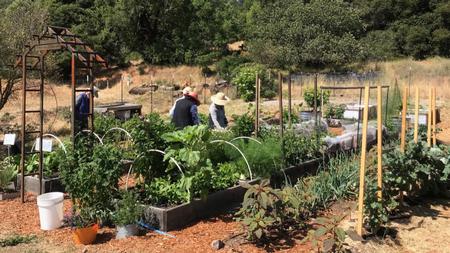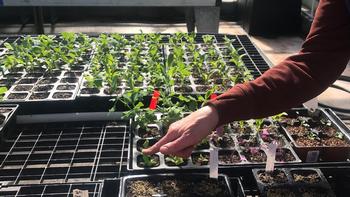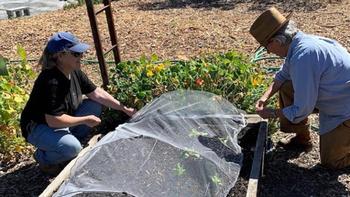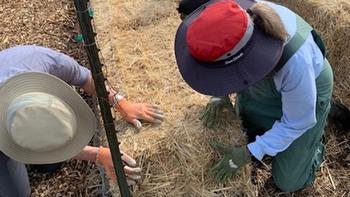News from the Edible Demo Garden
April 2023: A Year in the Garden

There is always something to do in the garden. Even during rainy March, Master Gardener volunteers were busy readying the garden for spring. Last calendar year, volunteer hours in the Edible Demo Garden totaled 932. That’s an average of about 20 hours a week of gardening activities performed by a dedicated group of 10 to 12 volunteers. There is a rhythm in the garden with a focus for each season and many overlapping tasks.
Spring

- Preparing garden beds – Compost and organic amendments are added to all the existing beds, and the straw bales are properly seasoned. Tilling is kept minimal to avoid disturbing beneficial soil organisms.
- Planting – Plants with larger seeds, can go directly into the ground when the soil is warm enough. Many, however, benefit from an earlier start in the greenhouse and will be ready for transplanting in about six weeks. Flowers are planted along with the edibles to attract pollinators and add interest to the garden.
- Protecting tender plants – Newly planted beds are covered with tulle fabric to protect the seedlings from the hungry birds. Tulle has proven to be the ideal bird deterrent. It is inexpensive and allows in sun and water.
- Checking irrigation lines – Drip irrigation is utilized throughout the garden and the lines and emitters are checked to ensure all the plants will be sufficiently watered.
Summer

- Harvesting – The ripened vegetables and fruit are picked, weighed, and boxed up for distribution in CSA (community supported agriculture) boxes or readied for sale at the IVC farm stand. All volunteers are trained to follow the strict standards for harvesting organic produce for public consumption.
- Planting – Edibles for late summer and fall are started in the greenhouse and planted in fallow beds.
- Feeding the plants – The well-prepared soil and seasoned straw bales reduce the need for additional fertilization. Organic amendments are added when planting seeds and new starts. Heavy feeders, like tomatoes, are given an occasional boost.
- Watering – Extra hand watering is needed to supplement the drip irrigation on hot summer days
Fall
The harvest extends into fall and preparations for winter begin. In fall volunteers are busy:
- Harvesting – The remainder of the annual summer edibles are picked along with the winter squash and cool season greens. Late harvests are donated to Homeward Bound.
- Cleaning up – Post harvest annual vines and plants are removed, and perennials are cut back. Garden trimmings are chopped up and added to compost. The straw bales are dismantled, and the straw spread as mulch.
- Planting – Winter crops such as cabbage, cauliflower, and beets are planted. Cover crops are sown in new and fallow beds to protect and enrich the soil.
Winter

- Planning – Plans begin for the next garden year. In collaboration with IVOF&G, seeds are ordered for the varieties to be planted in the spring.
- Mulching – Cardboard is used for sheet mulching in areas where weeds are a problem. Wood chips are added to the garden paths.
- Installing straw bales – New straw bales are obtained and placed in the garden in preparation for spring planting.
Tasks for All Seasons
- Weeding, weeding, and more weeding
- Composting
- Checking for disease and insect damage
- Protecting plants from critters, particularly gophers and birds
- Taking care of the worms in the worm bins
- Keeping accurate records to meet MOCA (Marin Organic Certified Agriculture) requirements
What Happens in the Garden Doesn’t Stay in the Garden
The primary goal for the garden is education. What is learned in the garden is shared with other Master Gardeners and the public through workshops, media, presentations, demonstrations, and other outreach efforts. The produce is a bonus. The estimated dollar value of edibles harvested during the last fiscal year was $4,183 and it is expected the amount will be higher this year. All the garden harvest is donated to the IVOF&G for the farmstand or community supported agriculture boxes. When they are not operating, the produce goes to Homeward Bound.
An Open Invitation
Visitors are always welcome in the garden whenever the volunteers are at work. Drop by anytime between 9 and 11 am on the first Friday of the month and enjoy a tour and an explanation of what is currently growing.
